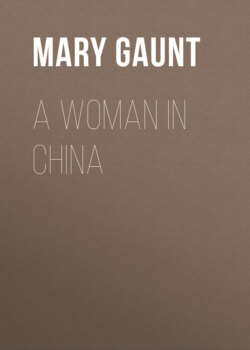Читать книгу A Woman In China - Mary Gaunt - Страница 9
На сайте Литреса книга снята с продажи.
Оглавление
Still, in spite of the mud and the dust, the streets are not without charm. They are lined with trees; indeed I think no city of its size was ever better planted. When once one has realised how treeless is the greater part of China, this is rather surprising. For look which way you will from the wall in the summer and autumn, you feel you might be looking down upon a wood instead of a city; the roofs of the single-storied houses are hidden by the greenery, and only here and there peeps out the tiled roof of a temple or hall of audience with the eaves curving upwards, things of beauty against the background of green branches. Curiously enough it is only from the walls that Peking has this aspect. Once in the network of alley-ways it seems as if a wilderness of houses and shops were crowding one on top of the other, as if humanity were crushing out every sign of green life. This is because there is to all things Chinese two sides. There is the life of the streets, mud-begrimed, dusty, seething with humanity, odoriferous, ragged, dirty, patient, hardworking; and there is a hidden life shut away in those networks of narrow alley-ways.
There is many a gateway between two gilded shop fronts, some black Chinese characters on a red background set out the owner's name and titles, and, passing through, you are straightway admitted into courtyard after courtyard, some planted with trees, some with flowering plants in pots—because of the cruel winter all Chinese gardens in the north here are in pots, sometimes with fruit-trees thick with blossom or heavy with fruit, and in the paved courtyards, secluded, retired as a convent, you find the various apartments of a well-arranged Chinese house; there are shady verandas, and dainty lattice-work windows looking out upon miniature landscapes with little hills and streams and graceful bridges crossing the streams. But only a favoured few may see these oases. For the majority Peking must be the wide-open boulevards and narrow hu t'ungs, fronted by low and highly ornamental houses, and shops so close together that there is no more room for a garden or growing green life than there is in Piccadilly. True there are trees in these boulevards, in Morrison Street, in Ha Ta Men Street, in the street of Eternal Repose that cuts them at right angles, but they would be but small things in the mass of buildings were it not for the courtyards of the private houses and temples that are hidden behind.
There are, too, in the streets p'ia lous or memorial arches, generally of three archways with tiled roofs of blue or green or yellow rising in tiers one above the other, put up in memory of some deed the Chinese delight to honour. And what the Chinese think worthy of honour, and what the Westerner delights to honour are generally as far apart, I find, as the Poles. In Ha Ta Men Street, however, there is a p'ia lou all of white marble, put up by the last Manchu Emperor in memory of gallant Baron von Kettler, done to death in the Boxer rising, but there, I am afraid, Chinese appreciation was quickened by European force.
We are apt to think that European influence in China is quite a thing of yesterday, that Baron von Kettler was the first man of note who perished in the inevitable conflict, and yet, when I looked at the eastern wall of the city, I was reminded, with a start, that European influence dates long before the Boxer time, long before the days of the Honourable East India Company, and many must have been the martyrs. There on the eastern wall stands the observatory, and clear-cut against the bright blue sky are astronomical instruments with dragons and strange beasts upon them. They were placed there by the Jesuits in the middle of the seventeenth century, and I know that those priests could not have attained so much influence without a bitter baptism of blood. They stand out as landmarks, those orbs and astrolabes, up and down the wall, even as they have come down through the centuries; monuments, as enduring as any Chinese p'ia lou, of faith and suffering; but the Jesuits were not the first to place astronomical instruments there. The Chinese were not barbarians by any means, though by some curious freak we Westerners have passed them in the race for civilisation, and, as long ago as the days of Kublai Khan, they had an observatory here by the wall. On the ground below, in a tree-shaded courtyard, there is an astrolabe with a beautiful bronze dragon for a stand, the dust-laden air of Peking has polished and preserved it, so that I can see but little difference between it and the newer instruments on the platform above—newer and yet two hundred and fifty years old.
And beyond the observatory in the north-east corner of the city is the Lama Temple, a temple with picturesque, yellowish-brown tiled roofs and spacious courtyards, in which are quaint old gnarled trees, and building after building in that curious state that is part beautiful, part slovenly decay, ruled over by hundreds of shaven, yellow-robed monks among whom, they say, it is not safe for a woman to go by herself. There is the Temple of Confucius, with surely the most peaceful courtyard in the world, and there are other temples, temples with courtyards and weird, twisted coniferous trees in them that are hundreds of years old, pagodas, and bells, and towers, and to each and all is attached many a story.
